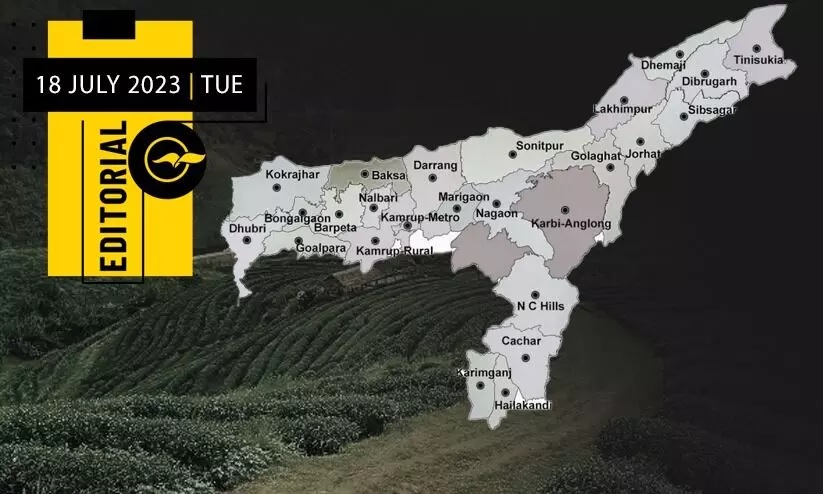
Constituency delimitation, i.e., elimination of Muslim visibility
text_fieldsAs the debate over the delimitation of assembly constituencies in Jammu and Kashmir continues, a similar situation has emerged in Assam. The allegation is that the Election Commission's decision to redraw constituencies there results in racial marginalization in effect. The All India United Democratic Front (AIUDF) has approached the Supreme Court alleging that the National Election Commission has submitted the delimitation draft in such a way as to ensure victory and rule for the BJP in the upcoming Parliament and Assembly elections. Eleven opposition parties including the Congress are protesting against the Election Commission. The opposition accuses the Commission, which has become a weapon of the BJP, of redrawing the constituencies based on the 2001 Census instead of using the more recent 2011, patently with vested interests, and in a manner without transparency or sufficient consultation with them and the civil society. Last week, opposition parties staged a sit-in in front of the Election Commission's office in the capital, alleging that they had ignored the matter despite their representation to the Election Commission.
On June 20, a committee comprising Chief Election Commissioner Rajeev Kumar, Commissioners Anoop Chandra Pandey and Arun Goyal released a draft of the delimitation of Assam's Parliament and Assembly seats. There was no increase in the total number of 126 assembly seats or 14 parliamentary seats over those created in the last re-election in 1976. However, the number of existing reserved seats for Scheduled Castes and Scheduled Tribes has been increased. Out of 16 seats, Scheduled Tribes will get three seats and Scheduled Tribes will get one more seat than the current eight. Each party has one seat in Parliament. One in Karbi Anglong district of western Assam and three in the autonomous Bodoland Teritorial Council region will be increased. Two seats were also added in Barak Valley.
AIUDF has approached the court arguing that the motive behind such hasty delimitation is to weaken the decisiveness of Muslim votes. According to the Election Commission's re-delimitation draft, Muslim majority constituencies in the state will be reduced from 29 to 22. In 90 constituencies native Assamese will be in majority and in 12 constituencies Bengali Assamese will be in majority. The purpose of this process is to reduce Muslim representation. It has come to light that the steps taken by Himant Biswa Sarma's BJP government on the lines of the Commission's delimitation plan aimed at marginalization of Muslims. Four days after the delimitation was announced on December 27 last year, three districts in the state (Bajali, Biswanath and Hojai), where Muslims had a significant numerical strength, were merged into one with a previously undivided district. A district was also merged with the adjacent one. Thus the number of districts in Assam was reduced from 35 to 31. The BJP government's aggressive program to reduce the visibility of Muslims by eliminating the districts itself comes from its concern that even if the constituency boundaries are redrawn, the purpose will not be achieved. In any reshuffle, the statistics used normally should be the most recent one. However, in the constituency delimitation exercise in Assam, the process is undertaken using the 2001 Census, setting aside the 2021 Census. This ploy is to prevent the impact of the increase in Muslim population in some constituencies reserved for Scheduled Castes and Scheduled Tribes. The official explanation is that the delimitation of constituencies was done in accordance with Section 8-A of the Representation of the People Act, 1950. However, according to the complaint filed in the court, if this law is applied, then this section does not give the authority to increase the number of constituencies.
What the extremist Hindutva-driven government in Assam led by Himant Biswa Sarma is attempting with the connivance of the central government is to make Muslims invisible by confining them to ghettos or by scattering them. The implementation of the Citizenship Amendment Act through the National Register of Citizens was targeted at the Muslim community, but that misfired. However, now the Assam government is moving ahead with efforts to turn NRC into a Muslim extermination register after fixing the faults of NRC. In typical sangh parivar style, the Himanta regime is going to extreme lengths to eliminate Muslims branding them as an enemy and a threat. While being a chief minister who could not arrest the soaring prices of vegetables, he put that blame on the Bengali Muslim 'Miya' community and issued a public appeal to exterminate them. And the constituency delimitation in Assam is part of the agenda to keep Muslims away from the legislatures in every way possible. The opposition should urgently step forward to beat this politics of elimination through an action plan, alongside the legal battle, of democratic struggle and its implementation.

























